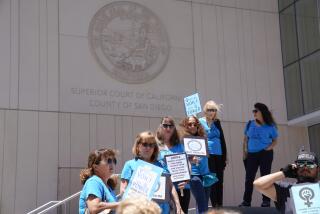Vigilantism Masks Real Threat to Kids
- Share via
Controversy is swirling around a new state law that permits police to notify communities of the presence of convicted sex offenders.
Two cities--one in Orange County and one in Los Angeles County--have become the first in Southern California to struggle with the ramifications of telling people that a former sex-offender lives nearby.
In Placentia, a paroled offender was fired from his job, pickets ringed his house and neighbors dialed 911 every time he left. In South Pasadena, a school passed out fliers with a released offender’s name, address and photograph.
No one wants a person likely to molest a child living next door. But legislators have tried to address a serious and complex problem, deviant sexual behavior, with an overly simplistic solution. Notification laws are an inadequate response to the problem of sexual offenses against children, which commonly are committed behind closed doors by a family member or friend.
These laws create an illusion of safety but do little to prevent such crimes. Rather, they encourage vigilantism, which forces offenders to move from place to place, making them unable to seek and complete treatment.
The danger in vigilantism is real. In New Jersey, two men broke into a house in the middle of the night and beat a man they mistakenly believed to be a recently paroled sex offender. In Washington and New Jersey, released convicts’ homes were destroyed by arson after their names were broadcast.
Washington, which has had notification laws on the books for seven years, quickly learned from the arson experience. It now holds community meetings that include information on the offender’s crime, how to recognize warning signs of abuse and what measures are being taken to monitor the offender. In addition, neighbors are strictly warned that harassment is illegal and will be prosecuted, and that acts of vigilantism could lead to repeal of the law.
The parolee in South Pasadena had not committed a sex offense in 14 years. He is reported to be suffering from a crippling kidney disease. Not only is he a public scapegoat, but his parents, who have lived in the community for 20 years, are also subject to vilification and possible violence.
Unlike other criminals, the sex offender endures a double punishment. The underlying assumption of the notification law is that, unlike killers, thieves and drug dealers, all sex offenders are incapable of reform. Therefore, after a lengthy prison term, the former sex offender is hounded by a notification law that makes it impossible for him to start a new life.
No one advocates that sex offenders be treated lightly. Sentences are stiff, and appropriately so. Judges are already required to consider the facts of the case, the history of the offender and the harm to the victim. They determine whether to sentence him to prison, confine him in a psychiatric facility or make some other appropriate disposition. Judges, like all of us, sometimes make mistakes. Still, the safest approach is to put more and better resources into giving them the information they need to determine the most effective penalty for the individual offender.
But California’s sweeping legislation allows police departments unfettered discretion to impose further punishment by alarming residents that a sex offender has moved into their neighborhood.
The Constitution bars punishing a person twice for the same crime, and federal district courts have stuck down community notification in a number of states.
We need to ask ourselves what community notification statutes really accomplish. Is their unstated purpose to let the public vent its anger at sex offenders, like a stoning in the Bible? Does the public prefer the illusion of protection rather than admit the reality of sex crimes committed against children?
The real solutions to the real threat include counseling and treatment in prison and after release, establishing neighborhood block watch programs for children and educating parents and children about unwanted sexual advances.
Community notification generates hysteria about a small group of people for a short period of time. It does not solve the problem, but merely moves it--and the offender--to someone else’s neighborhood.
More to Read
Sign up for Essential California
The most important California stories and recommendations in your inbox every morning.
You may occasionally receive promotional content from the Los Angeles Times.










